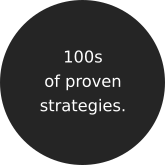Start a profitable website or blog
Free email course
by the MarbleHost Academy.
Creating a Winning Content Marketing Team: A Step-by-Step Guide
Are you thinking about starting a content marketing campaign for your business? Do you know how to structure a content marketing team? Here's what you need to know.
Step 1: Identify Your Goals
The first step in structuring a content marketing team is to identify your goals. Your goals are the foundation of your content marketing strategy. They will guide you in determining what type of content to create, who your audience is, and how you will measure success.
When identifying your goals, think about what you want to achieve with your content marketing campaign. Do you want to increase website traffic, generate more leads, or build brand awareness? Your goals should be specific, measurable, achievable, relevant, and time-bound.
Once you have identified your goals, you can determine what roles and responsibilities are needed on your team to achieve those goals. For example, if your goal is to increase website traffic, you may need someone who is skilled in search engine optimization (SEO) to help optimize your content for search engines.
Step 2: Determine Your Budget
The next step is to determine your budget. How much money do you have to spend on your content marketing campaign? Your budget will determine how many people you can afford to have on your team and what tools and resources you can use.
When determining your budget, consider the cost of hiring employees or freelancers, as well as the cost of tools and resources such as content management systems, social media management tools, and analytics tools.
It's important to note that content marketing can be a long-term investment, and you may not see immediate results. However, it is still important to allocate a budget that is realistic and sustainable for your business.
Step 3: Define Roles and Responsibilities
Now that you know your goals and budget, it's time to define the roles and responsibilities of your content marketing team. Each role should be clearly defined to ensure everyone on the team knows what they are responsible for.
Here are some roles you might need:
- Content Manager: responsible for overseeing the entire content marketing strategy and ensuring it aligns with business goals.
- Writer/Editor: responsible for creating and editing content such as blog posts, ebooks, and whitepapers.
- Graphic Designer: responsible for creating visual content such as infographics and social media graphics.
- SEO Specialist: responsible for optimizing content for search engines and improving website rankings.
- Social Media Manager: responsible for managing social media accounts and creating engaging social media content.
- Email Marketer: responsible for creating and sending email campaigns to subscribers.
- Analytics Expert: responsible for tracking and analyzing data to measure the success of the content marketing campaign.
You may not need all of these roles, or you may need additional roles depending on your specific goals and budget.
Step 4: Hire Your Team
Now that you know what roles you need on your team, it's time to start hiring. Look for people with the skills and experience necessary to fulfill the roles you've defined. You may consider hiring full-time employees, part-time employees, or freelancers depending on your budget and needs.
When hiring, be sure to consider not only the candidate's skills and experience, but also their fit with your company culture and their ability to work collaboratively with others on the team.
It's important to have a clear job description and interview process for each role to ensure you hire the right people. You may also want to consider conducting a skills test or requesting a portfolio of work to evaluate the candidate's abilities.
Step 5: Develop a Content Calendar
Once you have your team in place, it's time to start planning and creating content. A content calendar is a great tool for organizing your content strategy and ensuring that everyone on the team is on the same page.
A content calendar should include the following:
- Content topics
- Deadlines
- Assigned team member
- Publishing platform
- Keywords and SEO information
- Links to related content
By having a content calendar, you can ensure that you are creating content that aligns with your goals and that you are publishing content regularly to keep your audience engaged.
Step 6: Measure and Analyze Results
Finally, it's important to measure and analyze the results of your content marketing campaign. This will help you determine what is working and what isn't so you can make adjustments as needed.
Some metrics you may want to track include website traffic, lead generation, social media engagement, and email open rates.
Using analytics tools, you can track these metrics and analyze the data to gain insights into the effectiveness of your content marketing campaign. You can then use this information to make informed decisions about how to optimize your strategy for better results.
Conclusion
Structuring a content marketing team takes careful planning and consideration of your goals and budget. By identifying your goals, defining roles and responsibilities, hiring the right people, developing a content calendar, and measuring and analyzing results, you can build a successful content marketing campaign that drives traffic, generates leads, and builds brand awareness for your business.
Join MarbleHost Academy
Discover how to create a profitable website or a blog.
Join our free email course and start making money right now.



 Guest author
Guest author


















